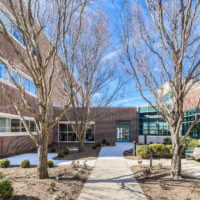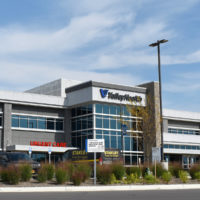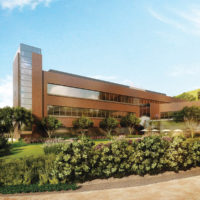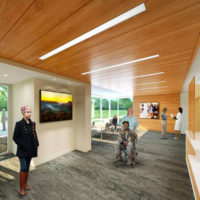Economic conditions across all sectors have been in a state of volatility since the COVID-19 pandemic arrived. It’s no surprise that many businesses and organizations are adopting a “wait and see” approach before investing in modernized or new facilities. Virginia Business explored the construction industry’s outlook last month in the feature Slowdowns Ahead.
“COVID-related disruptions are certainly contributing to uncertainty across the board,” Shockey President Jeff Boehm said in the story. “Neither the public sector nor the private sector is sure what’s coming next.”
One of the outliers to this period of uncertainty is healthcare. According to the AIA Consensus Construction Forecast Panel — a compiled aggregated data set consisting of leading economic forecasters — healthcare spending is projected to increase by two percent this year and another three percent in 2021.
The chart below contains three of the most positive outlooks (among eight sources of data) sourced by the AIA as part of its Consensus Construction Forecast:
Construction Industry Forecast: Health Sector
| Organization | Actual Spending (Billions of $) 2019 | Forecast Change 2020 | Forecast Change 2021 |
|---|---|---|---|
| Associated Builders & Contractors | 44.2 | 5.1% | 7.0% |
| Dodge Data & Analytics | 44.2 | 3.5% | 10.5% |
| Moody's Analytics | 45.6 | 13.8% | 3.4% |
“Healthcare construction is one of the few sectors expected to avoid a recession in this cycle,” said Kermit Baker, Chief Economist for the American Institute of Architects (July 20, 2020). “Even though elective health treatments have fallen off in recent months, demographics remain very positive for healthcare spending moving forward.”
The Rise of the Community Healthcare System
As the pandemic’s impact on the industry continues to ripple out from urban acute care facilities, healthcare systems have been focused on addressing the needs of patients within the communities in which they live. Here are a few of Shockey’s recent and current community healthcare projects:
 Heart & Vascular Center Addition in Winchester, Virginia
Heart & Vascular Center Addition in Winchester, Virginia
A new four-story wing now houses a 66,000-SF expansion to Winchester Medical Center’s (WMC) Heart & Vascular Center. Giving patients easy access to imaging and other services, the addition houses the cardiac and pulmonary rehabilitation program, an outpatient laboratory and new clinic and office space for more than 40 cardiovascular physicians and advanced practice clinicians (APCs). Architect: Noelker & Hull Associates, Inc.
 New Ambulatory Care Center in Berkeley County, West Virginia
New Ambulatory Care Center in Berkeley County, West Virginia
New Warren Memorial Hospital in Front Royal, Virginia
 Multi-Phased Hospital Expansion in Petersburg, West Virginia
Multi-Phased Hospital Expansion in Petersburg, West Virginia
For Grant Memorial Hospital, we will convert inpatient rooms into critical care rooms with accessible bathrooms and update medical gasses, casework and finishes. Next, we will demolish a special care unit and build a pharmacy with a cleanroom suite. The final phase transforms administrative offices into an oncology infusion clinic. Shockey will work while the hospital is occupied, following strict COVID-19 protocols. Architect: Kahler Slater
Commercial Construction Never Sleeps
The construction industry was deemed essential in the first few weeks of the pandemic, so Shockey has kept on building, delivering these healthcare projects on time. “[Director of Safety] Ron [Collins] and our safety team quickly sprung into action,” said Boehm, “going above and beyond to mitigate the impact of the coronavirus and keep our team and clients safe. Ron dedicated hours and hours of his time — running around on the hunt to acquire disinfectant solutions and masks when they were in short supply and the virus began spreading.”
Early in the crisis, Shockey’s safety team developed and implemented a program that included screening procedures, social distancing, face coverings, and easy access to disinfectant solutions. Shockey managed crew sizes and reduced the amount of close contact between workers. “We also require disinfecting, through daily cleaning of surfaces and common work areas, on each site. This is in addition to the day-to-day operations of a worksite and its teams,” Collins noted.
According to Collins, Shockey’s site leaders have taken a proactive stance, and flexibility has been key. When it came to PPE, for example, modifications had to be made because of vision and respiratory challenges. “Anti-fog became a battle, but our employees came through,” he said, “finding face coverings with better seals around the nose and cheeks.”
“It’s becoming clear that construction will look different as we move beyond the COVID-19 crisis to the new normal,” said Boehm.
Despite the pandemic, Shockey’s healthcare team remains dedicated and committed to providing healthcare building solutions that provide the safest, most efficient, appropriate, and value-driven service possible.
Said Boehm, “Whatever’s next, we’ll adapt, and when someone needs a new healthcare facility, we’ll be here.”


 Heart & Vascular Center Addition in Winchester, Virginia
Heart & Vascular Center Addition in Winchester, Virginia New Ambulatory Care Center in Berkeley County, West Virginia
New Ambulatory Care Center in Berkeley County, West Virginia
 Multi-Phased Hospital Expansion in Petersburg, West Virginia
Multi-Phased Hospital Expansion in Petersburg, West Virginia